Dolphin After Battery: Difference between revisions
No edit summary |
Pbcjohnston (talk | contribs) Finished adding pictures |
||
| Line 2: | Line 2: | ||
=== <big>After Battery/Crew's Berthing & Messing</big> === | === <big>After Battery/Crew's Berthing & Messing</big> === | ||
[[File]] | [[File:Dolphin Crew-2.jpg|left|500px]] | ||
<div style="text-align: justify;"><span style="color:#00008B"> | <div style="text-align: justify;"><span style="color:#00008B">The crew's berthing and messing compartment. This view is from the forward bulkhead looking aft. The stainless steel table is a permanent fixture. Cast steel or aluminum legs hold it to the deck and the 12 benches seem to be the lockers for the 12 bunks over the table. It was in the lower right foreground where the man photographed sitting at the table in a previous image was seated. This is a combined berthing and messing space, in a style typical of the USN of this period. The bunks are "triced up", so that the area can be used as a messing space. Later fleet submarines would have separate berthing and messing compartments. | ||
The watertight door in the background leads to the galley, CPO mess, and the generator room. The ladder and hatch in the left foreground exit the pressure hull just aft of the conning tower fairwater and just under the starboard side of the raised deck, (there are no good photos of this arrangement). Note the bright sunlight coming down the hatch. | |||
Across the after end of the compartment are the crews bathing and toilet facilities. | |||
<small>US Navy Photo Contributed by Roger Torgeson</small> | |||
[[File:Red bar sub new 2.jpg]] | |||
[[File:Dolphin Crew-2b.jpg|left|500px]] | |||
<div style="text-align: justify;"><span style="color:#00008B">Close up of the after starboard corner of the crew's mess and berthing. To the left can be seen the ladder to the main deck. The black box with gauges at the top appears to be a hydrogen monitor. One half of the boat's massive battery sits below the deck of this compartment. A build up of hydrogen gas could cause an explosion. Below that a locked cabinet appears to have four grapefruit sitting on its top. | |||
The bulkhead these objects are attached to is the forward wall of the crew's shower room. This space is a little less than twice the size of an enclosed telephone booth, maybe about 4 feet by 4 feet. | |||
Between the grapefruit and hydrogen detector is a frame for holding any number of notices that could range from a crew list, a watch bill or even a menu of the week's meals. It could even hold emergency procedures. In this photo it is empty. | |||
The water tight door gives a glimpse into the ships Galley. There seems to a number of holes from removed equipment. This same bulkhead can be seen behind the man seen through the door from the Control Room. | |||
To the right, along the after bulkhead, is one of the two crew sinks with polished stainless steel mirrors above. | |||
<small>US Navy Photo Contributed by Roger Torgeson</small> | |||
[[File:Red bar sub new 2.jpg]] | |||
[[File:Dolphin Crew-2c.jpg|left|500px]] | |||
<div style="text-align: justify;"><span style="color:#00008B">Across the after bulkhead are two wash basins for the enlisted crew. Just to the right of the right-hand basin is the inboard, fore and aft, bulkhead for the crew's toilet room. At the far right can be seen the aft facing door to this room. | |||
<small>US Navy Photo Contributed by Roger Torgeson</small> | |||
[[File:Red bar sub new 2.jpg]] | |||
[[File:Dolphin Crew-3.jpg|left|500px]] | |||
<div style="text-align: justify;"><span style="color:#00008B">The crew's shower room, starboard side aft. The hot water heater for the shower is seen as the short tank in the room. It may also supply hot water for the sinks. For this photo the four grapefruit have been removed from the box to the left of the shower door. | |||
<small>US Navy Photo Contributed by Roger Torgeson</small> | |||
[[File:Red bar sub new 2.jpg]] | |||
[[File:Dolphin Crew-4.jpg|left|500px]] | |||
<div style="text-align: justify;"><span style="color:#00008B">The crew's toilet room or "Head" as it is known in nautical terms. There seems to be only one toilet. It is seen to be a china bowl sitting on a special flushing chamber. The heads at this time were direct flush to sea so the method of flushing was a complicated and exacting procedure. | |||
<small>US Navy Photo Contributed by Roger Torgeson</small> | |||
[[File:Red bar sub new 2.jpg]] | |||
[[File:Dolphin Crew-4c.jpg|left|500px]] | |||
<div style="text-align: justify;"><span style="color:#00008B">Part of the flushing mechanism with a sea pressure gauge so you know when to open the flush valve. | |||
<small>US Navy Photo Contributed by Roger Torgeson</small> | |||
[[File:Red bar sub new 2.jpg]] | |||
[[File:Dolphin Crew-4d.jpg|left|500px]] | |||
<div style="text-align: justify;"><span style="color:#00008B">Close up of the bowl. This one head got a lot of use, and there are obvious signs of leakage and corrosion around the base. This would have been a maintenance item for the shipyard personnel. Later boats would have all toilet bowls made out of stainless steel when it was realized that the ceramic bowls could crack and shatter under depth charge attack. | |||
<small>US Navy Photo Contributed by Roger Torgeson</small> | |||
[[File:Red bar sub new 2.jpg]] | |||
[[File:Dolphin Crew-4e.jpg|left|500px]] | |||
<div style="text-align: justify;"><span style="color:#00008B">A lot going on in this picture. At the top is a lamp, minus the bulb, so men can use the stainless steel mirror to shave. The mirror reflects the underside of the bunk opposite it. The mirror itself hangs on the door for a cabinet that contains... what? Maybe cleaning supplies. | |||
The sink, counter, & back splash appears to be one assembled unit. A wash cloth or rag is stuffed into the niche above the sink. Between the two sinks is a liquid soap dispenser. It appears a towel has been tied below the sink for men to wipe their hands on. | |||
On the right the shiny column is actually the curved piece that wraps around the corner of the toilet room bulkheads. | |||
<small>US Navy Photo Contributed by Roger Torgeson</small> | |||
[[File:Red bar sub new 2.jpg]] | |||
[[File:Dolphin Crew-1.jpg|left|500px]] | |||
<div style="text-align: justify;"><span style="color:#00008B">Crew's messing and berthing, looking forward from the area around the sinks. This space had 30 bunks, 12 of which were two high and wide stacked over the crew's mess table and the 18 others were three bunks high on the port and starboard sides. The oval hatch in the deck was the access into the after battery well and the battery cells themselves. | |||
<small>US Navy Photo Contributed by Roger Torgeson</small> | |||
[[File:Red bar sub new 2.jpg]] | |||
[[File:Dolphin Crew-1b.jpg|left|500px]] | |||
<div style="text-align: justify;"><span style="color:#00008B">The crews mess table. It was stainless steel with a lip on the edges to prevent plates and other things from sliding off during rough weather. The large flat duct is the battery well ventilation and the round stanchions are bunk supports that have collars on them about a foot high off the table. The braces that support the bunks rest on these collars. | |||
<small>US Navy Photo Contributed by Roger Torgeson</small> | |||
[[File:Red bar sub new 2.jpg]] | |||
[[File:Dolphin AFT BTY-1.jpg|left|500px]] | |||
<div style="text-align: justify;"><span style="color:#00008B">The after battery compartment, similar to the forward battery compartment, was two levels, with the upper being the crew's berthing and messing, and the lower being the battery well itself. 120 more man-sized cells were stored here, along with the requisite electrical connectors and ventilation ducting. This is the view looking forward. There was not enough space in the battery well for a man to stand up. He could only crawl along the wooden deck planks. Prior to entering the well the crewman removed all metal from his body to ensure he would not accidentally short a battery cell and get electrocuted. | |||
<small>US Navy Photo Contributed by Roger Torgeson</small> | |||
[[File:Red bar sub new 2.jpg]] | |||
[[File:Dolphin AFT BTY-2.jpg|left|500px]] | |||
<div style="text-align: justify;"><span style="color:#00008B">The after battery well looking aft, with the huge disconnect switches on the aft bulkhead. | |||
<small>US Navy Photo Contributed by Roger Torgeson</small> | |||
[[File:Red bar sub new 2.jpg]] | |||
[[File:Dolphin AFT BTY-2b.jpg|left|500px]] | |||
<div style="text-align: justify;"><span style="color:#00008B">The huge after battery disconnect switches. When open, they completely isolated the after battery from the rest of the electrical bus. | |||
<small>US Navy Photo Contributed by Roger Torgeson</small> | |||
[[File:Red bar sub new 2.jpg]] | [[File:Red bar sub new 2.jpg]] | ||
Revision as of 17:48, 16 June 2023
After Battery/Crew's Berthing & Messing
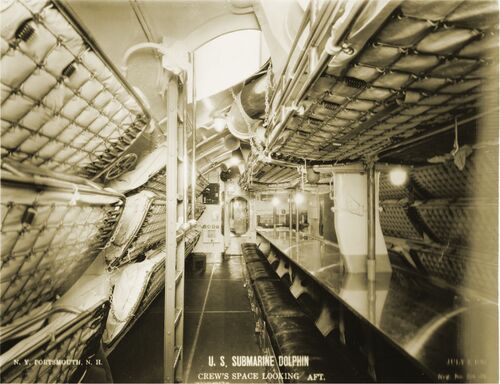
The watertight door in the background leads to the galley, CPO mess, and the generator room. The ladder and hatch in the left foreground exit the pressure hull just aft of the conning tower fairwater and just under the starboard side of the raised deck, (there are no good photos of this arrangement). Note the bright sunlight coming down the hatch.
Across the after end of the compartment are the crews bathing and toilet facilities.
US Navy Photo Contributed by Roger Torgeson

The bulkhead these objects are attached to is the forward wall of the crew's shower room. This space is a little less than twice the size of an enclosed telephone booth, maybe about 4 feet by 4 feet.
Between the grapefruit and hydrogen detector is a frame for holding any number of notices that could range from a crew list, a watch bill or even a menu of the week's meals. It could even hold emergency procedures. In this photo it is empty.
The water tight door gives a glimpse into the ships Galley. There seems to a number of holes from removed equipment. This same bulkhead can be seen behind the man seen through the door from the Control Room.
To the right, along the after bulkhead, is one of the two crew sinks with polished stainless steel mirrors above.
US Navy Photo Contributed by Roger Torgeson
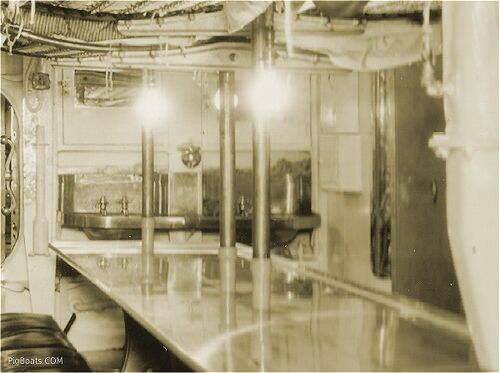
US Navy Photo Contributed by Roger Torgeson

US Navy Photo Contributed by Roger Torgeson

US Navy Photo Contributed by Roger Torgeson
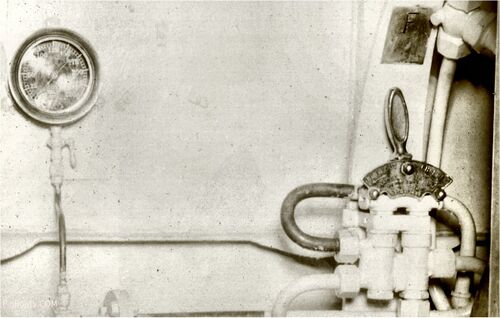
US Navy Photo Contributed by Roger Torgeson

US Navy Photo Contributed by Roger Torgeson

The sink, counter, & back splash appears to be one assembled unit. A wash cloth or rag is stuffed into the niche above the sink. Between the two sinks is a liquid soap dispenser. It appears a towel has been tied below the sink for men to wipe their hands on.
On the right the shiny column is actually the curved piece that wraps around the corner of the toilet room bulkheads.
US Navy Photo Contributed by Roger Torgeson
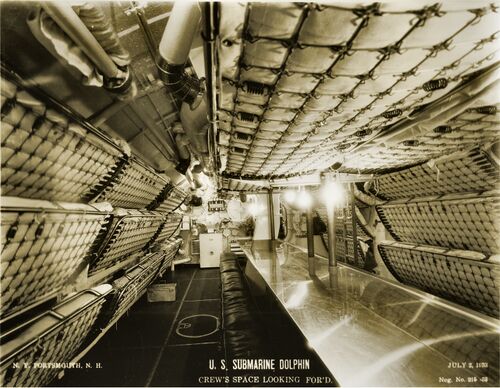
US Navy Photo Contributed by Roger Torgeson

US Navy Photo Contributed by Roger Torgeson

US Navy Photo Contributed by Roger Torgeson
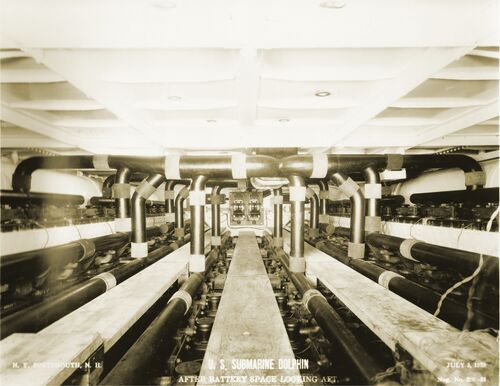
US Navy Photo Contributed by Roger Torgeson
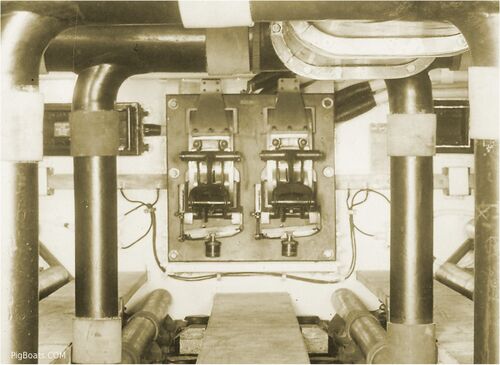
US Navy Photo Contributed by Roger Torgeson
Page created by:
Ric Hedman & David Johnston
1999 - 2023 - PigBoats.COM©
Mountlake Terrace, WA, Norfolk, VA
webmaster at pigboats dot com
